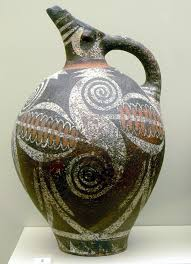Introduction
Imagine stepping into a world where myths come alive, where labyrinths and legends intertwine. The Minoan civilization, one of the most fascinating ancient cultures, thrived over 3,500 years ago on the island of Crete. Central to this enigmatic society was the Palace of Knossos, a sprawling architectural wonder often linked to the myth of the Minotaur. But what led to the rise of this sophisticated civilization, and why did it ultimately decline? Let’s delve into the captivating story of the Minoans and their crowning architectural achievement.
Who Were the Minoans?

The Minoans were an advanced Bronze Age civilization that flourished between 2000 and 1450 BCE. Named after the mythical King Minos, they were known for their maritime prowess, artistic achievements, and intricate palaces. Their society revolved around trade, culture, and religion, making them a hub of the ancient Mediterranean.
The Island of Crete: The Cradle of Civilization
Crete’s strategic location in the Aegean Sea played a vital role in the rise of the Minoan civilization. This island served as a bridge between Europe, Asia, and Africa, enabling the Minoans to establish trade routes that extended far and wide. The abundance of natural resources, fertile lands, and access to the sea provided the perfect environment for growth.
The Architectural Marvel of Knossos
What Made the Palace of Knossos Unique?
The Palace of Knossos, located near modern-day Heraklion, is often described as the heart of the Minoan civilization. Spanning over 20,000 square meters, it featured an intricate layout of rooms, courtyards, and corridors. The architecture was ahead of its time, boasting advanced features like drainage systems, storage facilities, and even early forms of air conditioning.
The Labyrinth Legend
Knossos is famously associated with the myth of the Minotaur, a half-man, half-bull creature said to dwell in a labyrinth beneath the palace. While the labyrinth may be a metaphor for the palace’s complex layout, it adds an air of mystery and intrigue to the site.
Also Read: Elevating Feline Hygiene: A Review of the Pet Zone Smart Scoop
Minoan Art and Culture
Vibrant Frescoes
One of the most striking features of Minoan culture was their vibrant frescoes. These wall paintings depicted scenes of nature, daily life, and religious rituals. The “Bull-Leaping Fresco,” for instance, captures the dynamism and athleticism of a ceremonial sport unique to the Minoans.
Religion and Rituals
The Minoans were deeply spiritual, worshiping a pantheon of deities, many of whom were female. The Snake Goddess, often depicted holding serpents, symbolized fertility and renewal. Rituals often took place in sanctuaries or peak shrines, emphasizing their connection to nature.
The Economic Powerhouse
Trade Networks
The Minoans were master traders, exporting goods like olive oil, wine, pottery, and textiles. Their ships reached destinations as far as Egypt, the Levant, and mainland Greece. These trade networks not only enriched their economy but also facilitated cultural exchange.
Agricultural Innovations
Advanced agricultural techniques allowed the Minoans to sustain a large population. They cultivated olives, grapes, and wheat, contributing to their prosperity and self-sufficiency.
The Decline of the Minoan Civilization
Natural Disasters
The Minoan civilization faced a series of devastating natural disasters, including earthquakes and volcanic eruptions. The eruption of Thera (modern-day Santorini) around 1600 BCE is believed to have caused significant damage to Crete and disrupted their trade networks.
Invasion and Conquest
The final blow came from the Mycenaeans, a rising power from mainland Greece. By 1450 BCE, the Mycenaeans had taken over Knossos, marking the end of the Minoan dominance.
The Legacy of the Minoans
Although the Minoan civilization faded, their influence persisted. Their artistic styles, religious symbols, and architectural techniques were adopted by later cultures, including the Mycenaeans and classical Greeks.
Rediscovery of Knossos
Sir Arthur Evans
The Palace of Knossos was rediscovered in the early 20th century by British archaeologist Sir Arthur Evans. His excavation revealed a treasure trove of artifacts and provided insights into Minoan life. However, his restoration methods have been a topic of debate among scholars.
Modern-Day Significance
Today, Knossos is a major tourist attraction and a symbol of Crete’s rich history. It continues to captivate archaeologists and visitors alike, offering a glimpse into an ancient world.
Lessons from the Minoans
The rise and fall of the Minoan civilization remind us of the fragility of human societies. Despite their advancements, they were vulnerable to natural and human-made disasters. Their story serves as both a celebration of human ingenuity and a cautionary tale.
Also Read: The Essential 5 Software Every Accountant Should Master
Conclusion
The Minoans and their magnificent Palace of Knossos stand as a testament to the creativity and resilience of ancient civilizations. From their vibrant art to their advanced architecture, they left an indelible mark on history. While their decline remains a puzzle, their legacy continues to inspire and intrigue. As we walk through the ruins of Knossos, we are reminded of the timeless allure of the past and the enduring power of human imagination.
FAQs
1. What was the purpose of the Palace of Knossos? The Palace of Knossos served as a political, religious, and economic center for the Minoan civilization. It housed administrative offices, storage facilities, and ceremonial spaces.
2. How advanced was Minoan architecture? Minoan architecture was highly advanced, featuring multi-story buildings, sophisticated drainage systems, and natural ventilation techniques.
3. What caused the decline of the Minoan civilization? The decline was due to a combination of natural disasters, such as the Thera eruption, and invasions by the Mycenaeans.
4. What is the myth of the Minotaur? The Minotaur myth involves a half-man, half-bull creature that lived in a labyrinth beneath the Palace of Knossos. It symbolizes the palace’s complex structure.
5. Can visitors explore the Palace of Knossos today? Yes, the Palace of Knossos is open to visitors and offers a fascinating glimpse into Minoan history and culture.


